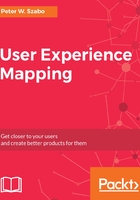
Card
The size, the shape, and what's on the back of the card are all irrelevant. As long as it's writable and movable, almost any object can serve as a medium for your story. With that said, a stone tablet is a bit less practical than a sticky note (often called Post-it note after the famous brand), so most people prefer sticky notes for story cards.
The biggest advantage is that they stay on a vertical surface, like a wall. Also, user story maps are often created on walls. This has many benefits. First of all, it forces people to stand up. This creates much better discussion dynamics, while also shortening the average length of the meeting, forcing people to focus, and optimizing the communication. More importantly, my personal observation is that people will reach an agreement much faster when they are standing up and at arm's length from each other.
The other, more subtle advantage of using a wall is that most of the time you can keep your sticky notes there for a while. If not, you can take a photo of them. Some teams use a table. The problem with a table is that people might sit around it. This will create a situation where some people see the cards upside-down. If you are the storyteller, chances are that they will arrange for your comfort. This will lead to a one-sided conversation, the kind you want to avoid. On the other hand, when you all stand in front of the wall, everyone will be on the same side, literally. The ideal room for telling user stories has no tables and no chairs at all. Just some white walls and empty space, so people can freely move around and explore.
To write the stories to the cards, you could use one of the templates I have shown before, or create your own style. The only advice I have here is to use the same style or template for all cards. Contrary to Internet forums, all caps help the communication on hand-written story cards. Most of the time it's better to write only the keywords on hand-written story cards, instead of the full story. That will make scannability easier. Alternatively, you can use a highlighter to give emphasis to the most important keywords.
After you have created your story cards, it's time to invite people to the conversation. Don't forget to bring a few empty cards, or blank sticky notes to the meeting, because new user stories can emerge during the conversation.